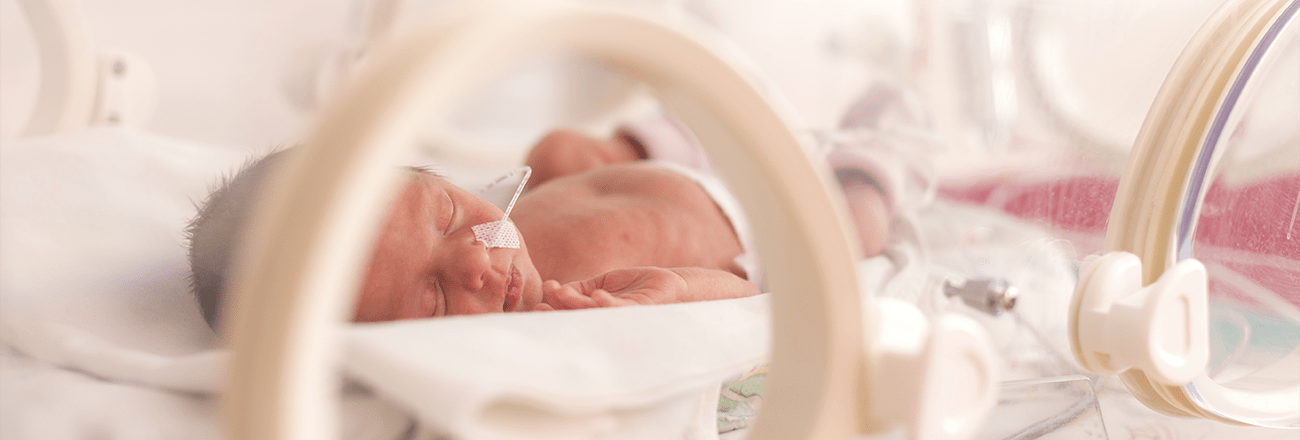Approximately 11% of babies worldwide are born premature. Most babies born at 32 weeks of pregnancy have only a few temporary health issues that require a stay in the NICU for a few days to a few weeks. At 32 weeks, babies still have a couple months to go before reaching their full birth weight, but they’re well developed. However, most babies who are born very preterm and extremely preterm have extremely low birth weight and a higher risk of complications and health problems than a baby born at 32 weeks. Babies born at 26-28 weeks have an increased risk for medical complications and disabilities such as cerebral palsy, deafness, blindness, and neurological problems and may face an extended stay in the NICU. Babies born at 26-28 weeks gestation have the following characteristics that require additional specialized care and environmental considerations:
- Extremely low birth weight.
- Most likely, their eyes are closed
- Little muscle tone, and most move very little.
- Almost all require treatment with oxygen, surfactant, and mechanical assistance to help them breathe.
- Too immature to suck, swallow, and breathe at the same time, so they must be fed through a vein (intravenously) until they develop these skills.
- Often can’t yet cry or have constricted cries due to intubation
- Sleep most of the day.
“Extremely low birth weight infants require a different type of care. They still need sound and stimulation, but at a much lesser degree, “ says Angela Howell, Medical Equipment Planner at Mazzetti, “They need a much closer line of sight as opposed to being in a room by themselves because nurses can see any changes before being detected by a monitor.”
The outcomes of extremely low birth weight (ELBW) infants (babies born at 28 weeks gestation or less and weighing less than 1,000 grams) have improved greatly due to dedicated Small Baby Units.
Small Baby Units are a single location separated from the main Neonatal Intensive Care Unit (NICU) with their own dedicated team of professionals. The smaller units are a darker and quieter environment that also provide parents of ELBW infants an opportunity to bond with other families sharing similar experiences. As of 2019, there are only nine Small Baby Units in the US.
Prior to the development of small baby units and standardized care, practice approaches were inconsistent. As a result, survival rates for ELBW infants were inferior. Small baby units were developed to address this issue. By providing guidelines based on evidence-based practice, caregivers were able to focus on the holistic care of the infant. The end goal being to improve survival rates, engage the family early on in their care, and improve neurological development.
According to an article in the Journal of the American Academy of Pediatrics, “In recent years, the survival rates for ELBW infants have improved with the latest advances in neonatal intensive care, but many are still released from the hospital with significant challenges, including neurodevelopmental delays and/or chronic medical problems. Our goal was to improve these outcomes by utilizing a dedicated team with expertise in the care of this population.”
Why Lighting Matters
Lauren Schwade, Senior Lighting Designer at Mazzetti, chose a career in lighting design because of the impact it had already had on her family. Lauren is the aunt of three nieces that spent the first days of their lives in the NICU. “I got into healthcare lighting design to make the experience better for the family and easier on the staff so they can focus more on patients, “Lauren said, “there are so many aspects that aren’t commonly focused on that can make a big difference. If you are more content as a patient, you heal faster. If you are happier as staff, you work more efficiently.”
The specialized dim and day/night cycled lighting in Small Baby Units considers the lack of circadian rhythm and light sensitivity in premature newborns. A newborn baby’s sleep cycle requires up to 18 hours of sleep, broken up into multiple short periods. Babies develop a circadian rhythm around four to six months of age, at which point they tend to sleep in larger blocks of time. Premature newborns can have abnormal blood vessel development in the retina making them more sensitive to bright light.
In addition, bright light in a Small Baby Unit can have the following damaging effects:
- Excessive Stimulation
- Increased heart and respiratory rates
- Decreased oxygen saturations
Conversely, dim light levels result in lower respiratory rates and activity, and reduced time on mechanical ventilation and oxygen support. Dim lighting can also serve as a signal for family and staff to observe quiet time and reduce overall light brightness around them (getting off their cell phones/tablets etc. at night). In turn, this aids in the comfort and healing process of the infant. Additionally, lights can be programmed to dim automatically at a preset time of day instead of taking a nurse away from important tasks to dim lights manually.
By providing day/night cycled lighting studies have shown many benefits to premature newborns including:
- Spent more regulated time sleeping after they were released
- Increased weight gain and oral feedings
- Decreased number of days on ventilator
- Enhanced motor condition
- Less overall fussiness
In addition, a smarter, more intuitive lighting control system that can aid in day/night cycled lighting keeps nurses and family members where they need to be (near the baby) vs. adjusting technology.
